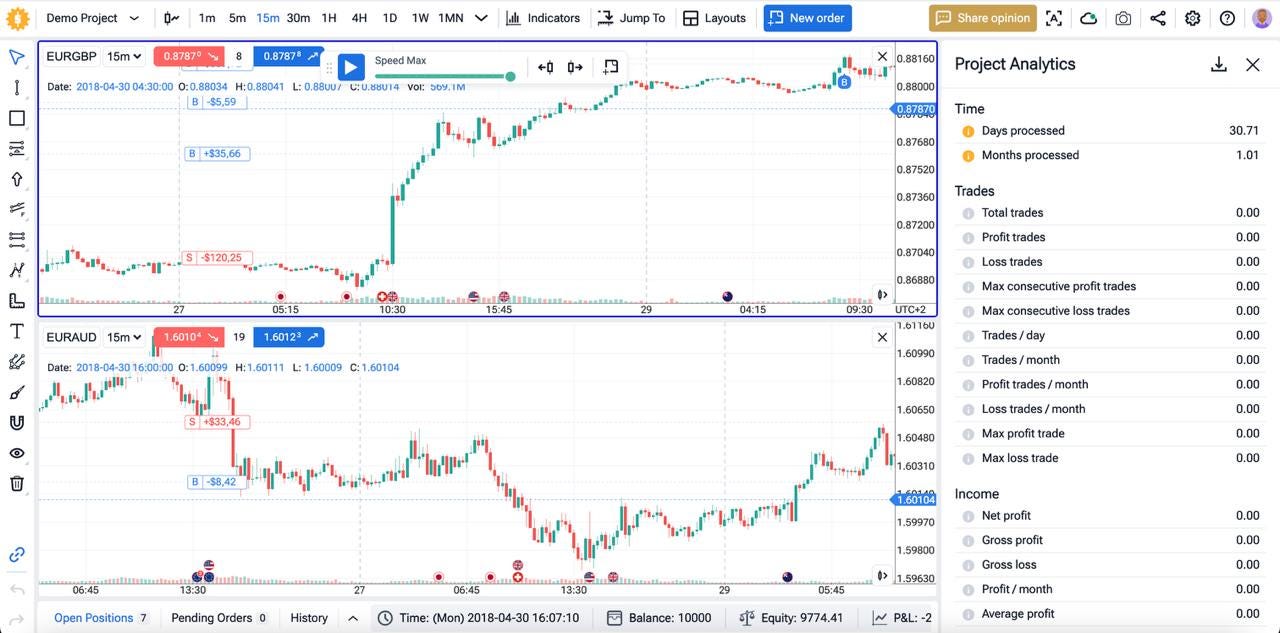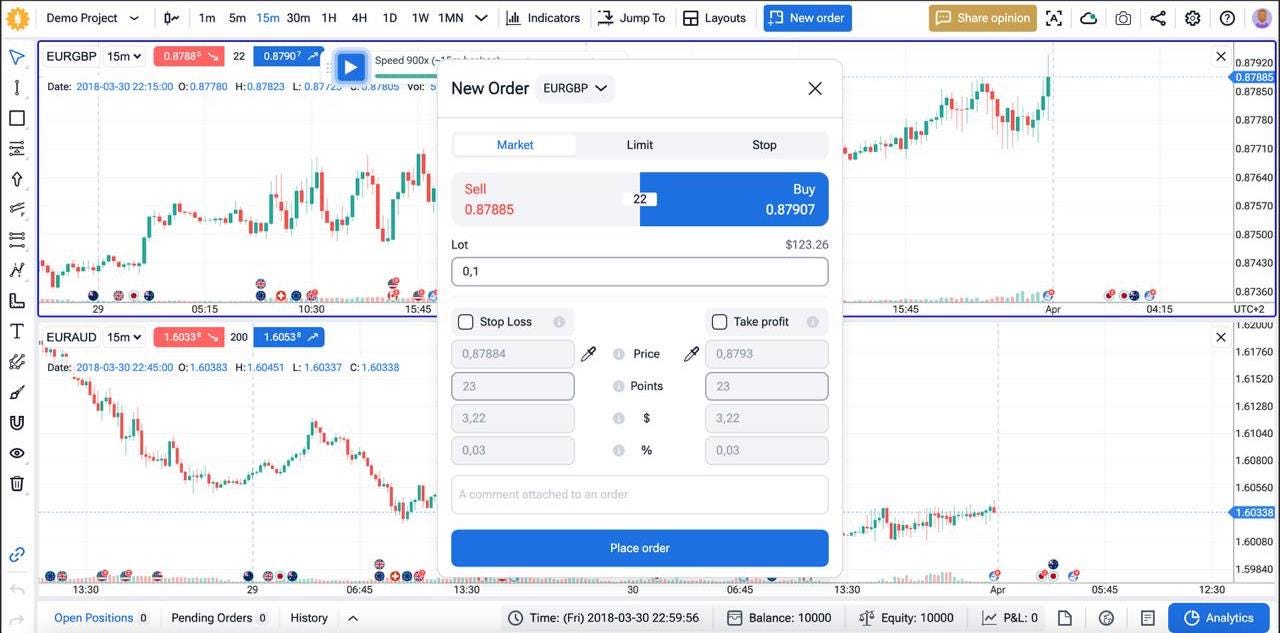Summarize at:
Testing your strategy before using real money is one of the smartest things you can do in trading. This applies to all markets, and ETFs are no exception. With the right ETF backtest tool, you can see how a strategy might have worked in the past and decide if it’s worth trying in live conditions.
In 2025, more traders are focusing on ETFs. They’re flexible, easy to access, and allow you to trade entire sectors or themes with just one instrument. But like any market, trading ETFs without testing can lead to mistakes. That’s why ETF backtesting has become an important step for traders of all levels.
In this article, we’ll cover the basics of ETFs, where and how to trade them, and most importantly — how to backtest ETF strategies using the best tools available this year.
What are ETFs?
ETFs, or exchange-traded funds, are investment instruments that track a group of assets. These could be stocks, commodities, bonds, or even currencies. When you buy an ETF, you’re buying a small piece of a larger portfolio that follows a specific index or sector.
For example, if you buy a tech ETF, it might include shares of companies like Apple, Microsoft, and Nvidia. This allows you to get exposure to the whole tech sector without buying each stock separately.
ETFs are traded on regular stock exchanges, just like individual stocks. Their price changes throughout the day based on supply and demand. Many traders and investors use them because they are simple, affordable, and offer instant diversification.
There are different types of ETFs:
- Stock ETFs (e.g., S&P 500, Nasdaq-100)
- Sector ETFs (e.g., healthcare, energy, tech)
- Commodity ETFs (e.g., gold, oil)
- Bond ETFs (e.g., US treasuries, corporate bonds)
- Thematic or strategy ETFs (e.g., ESG, dividends, momentum)
Because they follow specific markets or ideas, ETFs can be good for short-term trading or long-term investing. That’s why many traders look to test strategies across different ETFs using an ETF backtest tool.

Benefits of ETF Trading
ETFs are popular for good reasons. They offer several benefits that make them useful for both beginners and experienced traders:
1. Diversification
One ETF can give you access to dozens or even hundreds of assets. This reduces risk because you’re not depending on just one stock or bond.
2. Low Costs
Most ETFs have low management fees compared to mutual funds. Plus, many brokers now offer commission-free ETF trading.
3. Liquidity
ETFs trade like stocks. You can buy and sell them anytime during market hours, which makes them easy to use for short-term strategies.
4. Transparency
You can usually see what’s inside the ETF. This helps you understand what you’re trading.
5. Strategy Variety
There are ETFs for almost every market, sector, or strategy. You can use them to follow trends, hedge positions, or invest in long-term themes.
Because of these benefits, many traders test strategies before risking real money. That’s where an ETF backtest tool becomes useful. It lets you see how your strategy might have worked in the past.
Where to Trade ETFs
You can trade ETFs on most major stock trading platforms. These include:
- Interactive Brokers
- TD Ameritrade
- E*TRADE
- Fidelity
- Robinhood
- Saxo Bank
- IG
Each platform offers access to a variety of ETFs, including US and international funds. Some are better for active traders, while others suit long-term investors.
But we are talking here about backtesting, not trading. So iIf you want to backtest ETF strategies before live trading, you might need a separate ETF backtest software. Trading platforms often don’t offer advanced testing tools, so many traders use dedicated software like Forex Tester Online to test their ETF setups.
What Do You Need for Trading ETFs in Profit?
Trading ETFs can be simple, but making a profit takes more than just clicking buy and sell. Here are the key things you need to trade ETFs wisely:
1. Market Knowledge
Understand what drives the ETFs you’re trading. A gold ETF will react to different factors than a tech ETF. Learn what affects prices so you can react better.
2. Proper Timing
Some traders use technical indicators, moving averages, or momentum tools to find better entry and exit points. Timing matters, especially in short-term trading.
3. Backtesting
This is one of the most important steps. Before using real money, you should backtest ETF strategies to see how they would have performed in the past. Testing gives you confidence in your setup and helps you avoid surprises.
Using an ETF backtest tool like Forex Tester Online, you can try different approaches and see which ones actually worked. Backtesting lets you adjust your strategy and find what fits your style — before you risk a single dollar.
If you want to trade ETFs with a real chance of profit, backtesting is not optional. It’s your safety net.
How to Backtest ETFs in 2025
If you want to trade ETFs with confidence, you need to test your strategy first. The best way to do that is with an ETF backtest tool like Forex Tester Online. It runs in your browser and helps you test ideas using real historical data — without risking real money. As of April 2025, it supports 48 ETFs, and this list is constantly expanding.
Here’s how to backtest ETF strategies in 2025 using Forex Tester Online:
Step 1: Get Access
- Go to the Forex Tester Online website.
- Click “Get Started” to view features, assets, and pricing.
- Choose a subscription plan (yearly or lifetime).
- Create your account and complete the payment.
Once your account is ready, you’ll land on the dashboard where you can start building your backtesting projects.
Step 2: Create a Project
- Click on “+ New Project.”
- Choose the ETFs or other symbols you want to test.
- Set your starting deposit (virtual money), time zone, and testing period.
- Name your project and hit “Create.”
Your project will appear in the list. Click the Play button to begin testing.
Tip for beginners: You can also select a ready-made scenario, like the Covid-19 crash, and tweak it as needed. It’s a faster way to get started and still gives you full control.
Step 3: Start ETF Backtesting
Now the fun part begins. Use charts, indicators, and strategy tools to build your setup. Then simulate trades based on how the market moved in the past.

Key tools to help with your ETF backtest:
- Place demo trades manually
- Use one-click order entry directly on the chart
- Add technical indicators like RSI, MACD, moving averages
- See how news events affected ETF prices
- Adjust spreads, commissions, and other trading conditions
Use the “Jump To” feature to go straight to any key date or price level—this saves time when analyzing long periods.
You can test for weeks, months, or even years of data in just a few hours. And when you’re done, open the Analytics tab to review results.
Other Popular ETF Backtesting Tools
Alongside Forex Tester Online, here are a few tools traders use for ETF backtesting:
- TradingView – good for visual setups, but limited for detailed backtesting.
- MetaTrader (MT4/MT5) – can backtest with scripts, but ETF data is often limited.
- Portfolio Visualizer – best for long-term ETF portfolio analysis, not active trading.
- Amibroker – advanced scripting tool, good for custom strategies but not beginner-friendly.
- NinjaTrader – strong backtesting and market replay, mostly used for futures.
Conclusion
Trading ETFs can be simple, but trading them profitably takes planning and testing. Without backtesting, it’s hard to know if a strategy really works — or if you’re just guessing.
That’s why using an ETF backtest tool is so important. Whether you’re trying to test a new setup or build a full ETF portfolio strategy, software like Forex Tester Online helps you practice and learn safely with real historical data.
If you’re serious about trading ETFs in 2025, don’t skip the testing phase. Use the right ETF backtest software, and give your strategy a fair chance.
Also read: How to backtest futures in 2025
FAQ
How to run backtesting ETF trading strategies for different market regimes?
To test strategies in different conditions — like bull, bear, or sideways markets — choose specific time periods that reflect those trends.
What are the parameters to analyze the outcome of ETF backtesting?
Key parameters include:
- Win/loss ratio
- Maximum drawdown
- Risk-to-reward ratio
- Average trade duration
- Net profit/loss
- Number of trades
These metrics help you understand the quality and consistency of your ETF strategy.
Can I backtest ETF portfolios, not just single ETFs?
Yes, you can backtest ETF portfolios by selecting multiple ETFs in your backtest project. With Forex Tester Online, you can sync charts, place trades on different instruments, and track their combined performance.
What timeframes can I use for ETF backtesting?
Forex Tester Online supports multiple timeframes — 1-minute, 5-minute, hourly, daily, and custom ones like 2m or 3h. You can switch between them and sync charts to test strategies at both short-term and long-term levels.
Can I use ETF backtest tools on mobile or Mac?
Yes. Forex Tester Online is browser-based and works on Mac, Windows, iOS, Android, and Linux. No installation is needed. You can backtest on your phone, tablet, or any device with internet access.
Forex Tester Online
Practice trading ETFs with our backtesting platform before risking real money
 ไทย
ไทย
 Tiếng Việt
Tiếng Việt
 Polski
Polski
 Türkçe
Türkçe
 Nederlands
Nederlands
 Română
Română
 한국어
한국어
 Svenska
Svenska



